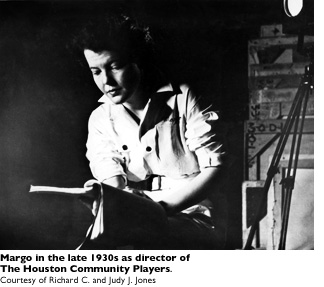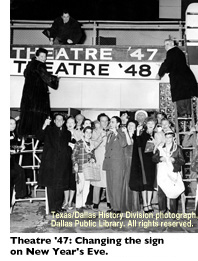Who she was
 Margo was “the Texas Tornado” who dreamed the resident theater into existence in the 1940s and ’50s. She was born in Livingston, Texas, in 1911 and died in 1955 in Dallas at the age of 43.
Margo was “the Texas Tornado” who dreamed the resident theater into existence in the 1940s and ’50s. She was born in Livingston, Texas, in 1911 and died in 1955 in Dallas at the age of 43.
Her importance
Margo was one of the major innovators and visionaries in American theater history. She founded Theatre ’47 in Dallas, a non-profit professional theater that was the first of its kind in the country, and ran it until her death in 1955. (The name changed with every year.) It provided the model for the resident theater movement of the 1960s and ’70s which transformed the American stage. She was a crucial figure in the early career of Tennessee Williams and discovered playwright William Inge. Her 1955 world premiere in Dallas of Lawrence and Lee’s Inherit the Wind – initially rejected by eight Broadway producers – saved a major American play.
Her theater philosophy
Margo was influenced by the European art theater, which she encountered in the 1930s, and combined this with a belief in “decentralization” – the movement to expand theater beyond Broadway’s commercial domination. Through her work for the Depression-era Federal Theater Project in Houston, she also absorbed the idea of an American national theater. In the early 1940s, Margo put all these concepts together in a plan to start a national network of nonprofit, professional theaters that would serve new audiences and nurture the artists soon to emerge from World War II. At the time, professional theater was virtually non-existent outside New York.
Her career in brief
Margo ran an amateur company in Houston in the ’30s and taught briefly at the University of Texas at Austin, then scored on Broadway in 1945 when she became the co-director of Tennessee Williams’ breakthrough drama The Glass Menagerie. As a direct result, she was offered the chance to start her own theater in Dallas, where she produced only new plays and classics with a success that startled the theater world. She directed other plays on Broadway, including Williams’ Summer and Smoke, but had a far better record with her experimental work in Dallas.
Her innovations
 Margo invented or fine-tuned many producing strategies, which she detailed in her book Theatre-in-the-Round (called the “bible” of the resident theater movement). Among them: low-cost arena staging, use of a resident company of professional actors, subscription sales, board development and community involvement. In addition, she excelled at marketing, publicity and fund-raising – bringing to all tasks a legendary personal fire and energy, and a commitment to theater as art.
Margo invented or fine-tuned many producing strategies, which she detailed in her book Theatre-in-the-Round (called the “bible” of the resident theater movement). Among them: low-cost arena staging, use of a resident company of professional actors, subscription sales, board development and community involvement. In addition, she excelled at marketing, publicity and fund-raising – bringing to all tasks a legendary personal fire and energy, and a commitment to theater as art.
Margo as a woman in theater
Margo was preceded by such figures as actor Eva Le Gallienne, who also sought to start a national theater, and Hallie Flanagan who ran the Federal Theater Project. She inspired followers Nina Vance and Zelda Fichandler, founders respectively of the Alley Theater in Houston (1949) and Washington’s Arena Stage (1950), and others, both men and women.
She was ahead of her time, yet (in the words of Emily Mann, artistic director of the McCarter Theater) “feels eerily like a contemporary … she ran her own theater, worked the commercial as well as non-commercial arenas and blazed the trail for the life I lead.” Unjustly forgotten since her early death, Margo’s comeback began with Helen Sheehy’s well-received biography, Margo: The Life and Theatre of Margo Jones (1989, SMU Press; paperback edition, 2005), and now continues with the nationally distributed documentary Sweet Tornado: Margo Jones and the American Theater.


